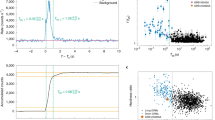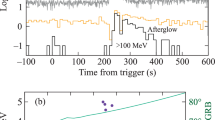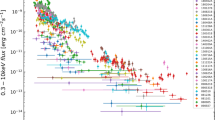Abstract
Gamma-ray bursts are traditionally classified as short and long bursts based on their \(T_{90}\) value (the time interval during which an instrument observes 5% to 95% of gamma-ray/hard X-ray fluence). However, \(T_{90}\) is dependent on the detector sensitivity and the energy range in which the instrument operates. As a result, different instruments provide different values of \(T_{90}\) for a burst. GRB 210217A is detected with different duration by Swift and Fermi. It is classified as a long/soft GRB by Swift-BAT with a \(T_{90}\) value of 3.76 s. On the other hand, the sub-threshold detection by Fermi-GBM classified GRB 210217A as a short/hard burst with a duration of 1.024 s. We present the multi-wavelength analysis of GRB 210217A (lying in the overlapping regime of long and short GRBs) to identify its actual class using multi-wavelength data. We utilized the \(T_{90}\)-hardness ratio, \(T_{90}-E_{p}\) and \(T_{90}-t_\mathrm{mvts}\) distributions of the GRBs to find the probability of GRB 210217A being a short GRB. Further, we estimated the photometric redshift of the burst by fitting the joint XRT/UVOT SED and placed the burst in the Amati plane. We found that GRB 210217A is an ambiguous burst showing properties of both short and long class of GRBs.






Similar content being viewed by others
Notes
References
Ahumada T., Singer L. P., Anand S., et al. 2021, Nat. Astron. https://doi.org/10.1038/s41550-021-01428-7
Amati L., Frontera F., Tavani M., et al. 2002, Astron. Astrophys., 390, 81. https://doi.org/10.1051/0004-6361:20020722
Amati L. 2006, Mon. Not. R. Astron. Soc., 372, 233. https://doi.org/10.1111/j.1365-2966.2006.10840.x
Antonelli L. A., D’Avanzo P., Perna R., et al. 2009, Astron. Astrophys., 507, L45. https://doi.org/10.1051/0004-6361/200913062
Arnaud K. A. 1996, Astronomical Data Analysis Software and Systems V, 101, 17
Barthelmy S. D., Barbier L. M., Cummings J. R., et al. 2005, Space Sci. Rev., 120, 143. https://doi.org/10.1007/s11214-005-5096-3
Bernardini M. G., Ghirlanda G., Campana S., et al. 2015, Mon. Not. R. Astron. Soc., 446, 1129. https://doi.org/10.1093/mnras/stu2153
Bloom J. S., Kulkarni S. R., Djorgovski S. G. 2002, Astron. J., 123, 1111. https://doi.org/10.1086/338893
Chand V., Banerjee A., Gupta R., et al. 2020, Astrophys. J., 898, 42. https://doi.org/10.3847/1538-4357/ab9606
Cheng L. X., Ma Y. Q., Cheng K. S., et al. 1995, Astron. Astrophys., 300, 746
Dimple, Misra K., Ghosh A., et al. 2021, GRB Coordinates Network, Circular Service, No. 29591, 29591
Evans P. A., Beardmore A. P., Page K. L., et al. 2009, Mon. Not. R. Astron. Soc., 397, 1177. https://doi.org/10.1111/j.1365-2966.2009.14913.x
Fenimore E. E., in ’t Zand J. J. M., Norris J. P., et al. 1995, Astrophys. J. Lett., 448, L101. https://doi.org/10.1086/309603
Fishman G. J., Meegan C. A. 1995, Ann. Rev. Astron. Astrophys., 33, 415. https://doi.org/10.1146/annurev.aa.33.090195.002215
Fletcher C., Fermi-GBM Team 2021, GRB Coordinates Network, Circular Service, No. 29536, 29536
Fong W., Berger E., Chornock R. et al. 2013, Astrophys. J., 769, 1
Fong W., Berger E., Margutti R., et al. 2015, Astrophys. J., 102. https://doi.org/10.1088/0004-637x/815/2/102
Foreman-Mackey D., Hogg D. W., Lang D., et al. 2013, Publ. Astron. Soc. Pacific, 125, 306. https://doi.org/10.1086/670067
Gal-Yam A., Fox D. B., Price P. A., et al. 2006, Nature, 444, 1053. https://doi.org/10.1038/nature05373
Gehrels N., Barthelmy S. D., Burrows D. N. et al. 2008, Astrophys. J., 689, 2. https://doi.org/10.1086/592766
Ghirlanda G., Nava L., Ghisellini G., et al. 2009, Astron. Astrophys., 496, 585. https://doi.org/10.1051/0004-6361/200811209
Goldstein A., Veres P., Burns E., et al. 2017, Astrophys. J. Lett., 848, L14. https://doi.org/10.3847/2041-8213/aa8f41
Golkhou V. Z., Butler N. R., Littlejohns O. M. 2015, Astrophys. J., 811, 93. https://doi.org/10.1088/0004-637X/811/2/93
Gupta R., Oates S. R., Pandey S. B., et al. 2021, Mon. Not. R. Astron. Soc., 505, 4086. https://doi.org/10.1093/mnras/stab1573
Jarosik N., Bennett C. L., Dunkley J., et al. 2011, Astrophys. J. Suppl., 192, 14. https://doi.org/10.1088/0067-0049/192/2/14
Kaneko Y., Bostancı Z. F., Göğüş E., et al. 2015, Mon. Not. R. Astron. Soc., 452, 824. https://doi.org/10.1093/mnras/stv1286
Kouveliotou C., Meegan C. A., Fishman G. J., et al. 1993, Astrophys. J. Lett., 413, L101. https://doi.org/10.1086/186969
Kumar A., Gupta R., Ghosh A., et al. 2021, GRB Coordinates Network, Circular Service, No. 29539, 29539
Li Y., Zhang B., Lü H.-J. 2016, Astrophys. J. Suppl., 227, 7. https://doi.org/10.3847/0067-0049/227/1/7
MacLachlan G. A., Shenoy A., Sonbas E., et al. 2012, Mon. Not. R. Astron. Soc., 425, L32-L35. https://doi.org/10.1111/j.1745-3933.2012.01295.x
MacLachlan G. A., Shenoy A., Sonbas E., et al. 2013, Mon. Not. R. Astron. Soc., 432, 857. https://doi.org/10.1093/mnras/stt241
Minaev P. Y., Pozanenko A. S. 2020, Mon. Not. R. Astron. Soc., 492, 1919. https://doi.org/10.1093/mnras/stz3611
Minaev P. Y., Pozanenko A. S. 2020, Astron. J. Lett., 46, 573. https://doi.org/10.1134/S1063773720090042
Pedregosa F., Varoquaux G. et al. 2011, JMLR, 12, 2825
Pei Y. C. 1992, Astrophys. J., 395, 130. https://doi.org/10.1086/171637
Piran T. 1999, Phys. Rep., 314, 575. https://doi.org/10.1016/S0370-1573(98)00127-6
Piran T. 2004, Rev. Mod. Phys., 76, 1143. https://doi.org/10.1103/RevModPhys.76.1143
Qin Y.-P., Chen Z.-F. 2013, Mon. Not. R. Astron. Soc., 430, 163. https://doi.org/10.1093/mnras/sts547
Qin Y.-P., Xie G.-Z., Xue S.-J., et al. 2000, Pub. Astron. Soc. Jpn., 52, 759. https://doi.org/10.1093/pasj/52.5.759
Sakamoto T., Barthelmy S. D., Cummings J. R., et al. 2021, GRB Coordinates Network, Circular Service, No. 29534, 29534
Sari R., Piran T., Narayan R. 1998, Astrophys. J. Lett., 497, L17. https://doi.org/10.1086/311269
Schlafly E. F., Finkbeiner D. P. 2011, Astrophys. J., 737, 103. https://doi.org/10.1088/0004-637X/737/2/103
Shrestha M., Smith R., Melandri A., et al. 2021, GRB Coordinates Network, Circular Service, No. 29535, 29535
Simpson K. K., Gropp J. D., Kennea J. A., et al. 2021, GRB Coordinates Network, Circular Service, No. 29521, 29521
Sonbas E., MacLachlan G. A., Dhuga K. S., et al. 2015, Astrophys. J., 805, 86. https://doi.org/10.1088/0004-637X/805/2/86
Tavani M. 1998, Astrophys. J. Lett., 497, L21, https://doi.org/10.1086/311276
Vianello G., Lauer R. J., Younk P., et al. 2015, arXiv:1507.08343
Willingale R., Starling R. L. C., Beardmore A. P., et al. 2013, Mon. Not. R. Astron. Soc., 431, 394. https://doi.org/10.1093/mnras/stt175
Yi T., Liang E., Qin Y., et al. 2006, Mon. Not. R. Astron. Soc., 367, 1751. https://doi.org/10.1111/j.1365-2966.2006.10083.x
Zheng W., Filippenko A. V., KAIT GRB Team 2021, GRB Coordinates Network, Circular Service, No. 29533, 29533
Acknowledgments
KM, RG and SBP acknowledge BRICS grant DST/ IMRCD/BRICS/PilotCall1/ProFCheap/2017(G) for the financial support. KGA is partially supported by the Swarnajayanti Fellowship Grant No. DST/SJF/PSA-01/2017-18, MATRICS grant MTR/2020/000177 of SERB, and a grant from the Infosys Foundation. This research is based on observations obtained at the 3.6m Devasthal Optical Telescope (DOT) during observing cycles DOT-2021-C1, a National Facility runs and managed by Aryabhatta Research Institute Observational Sciences (ARIES), an autonomous Institute under the Department of Science and Technology, Government of India. This research has used data obtained from the High Energy Astrophysics Science Archive Research Center (HEASARC) and the Leicester Database and Archive Service (LEDAS), provided by NASA’s Goddard Space Flight Flight Flight Center and the Department of Physics and Astronomy, Leicester University, UK, respectively.
Author information
Authors and Affiliations
Corresponding author
Additional information
This article is part of the Special Issue on “Astrophysical Jets and Observational Facilities: A National Perspective”.
Appendix
Appendix
1.1 Afterglow properties
The afterglow of the GRB can be well explained by the synchrotron fireball model (Piran 1999). The spectra, as well as the light curves, consist of a combination of power-law and broken power-law characterized by electron distribution index p (Sari et al. 1998; Piran 2004). We used the spectral and temporal indices to constrain p and the break frequencies using well-known closure relations (Sari et al. 1998). For this purpose, we fitted the X-ray and optical light curves/spectra at different epochs with single and broken power-law models. Both X-ray and optical light curves are well explained with a single power with indices values of \(1.10 \pm 0.1\) and \(0.65\pm 0.02\), respectively. The values of spectral indices at different epochs are given in Table 4. At around 0.3 ks, the spectral index is almost the same for optical and X-ray within the errorbar, suggesting no cooling break between X-ray to optical data. However, we found that the X-ray spectral index is almost twice the optical index at later epochs, indicating some break. So, we further created the spectral energy distributions using optical and X-ray data at two epochs centered at \({\sim }0.27 \) and \({\sim }\)125 ks. We fitted the SEDs with power-law and broken power-law models. The SED at the early epoch is best fitted with a single power-law with an index of \(0.607\pm 0.02\). However, the SED at the later epoch is best fitted with a broken power-law with indices \(0.65^{+0.08}_{-0.07}\) (pre-break) and \(1.32^{+0.28}_{-0.21}\) (post-break) and a break at \(1.7\pm 0.3 \times 10^{17}\) Hz, which we identify as a cooling break. The best-fitted SEDs are shown in Figure 7.
The optical/X-ray SEDs at two different epochs (\(\sim \)270 s and at \(\sim \)1.45 days after the trigger). The SED at the earlier epoch is well fitted with a simple power-law with a spectral index of 0.61\(^{+0.03}_{-0.02}\). However, a spectral break can be seen at the later epoch, which is identified as the synchrotron cooling break.
Rights and permissions
About this article
Cite this article
Dimple, Misra, K., Ghosh, A. et al. GRB 210217A: a short or a long GRB?. J Astrophys Astron 43, 39 (2022). https://doi.org/10.1007/s12036-022-09822-x
Received:
Accepted:
Published:
DOI: https://doi.org/10.1007/s12036-022-09822-x





